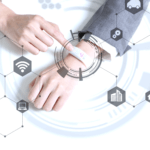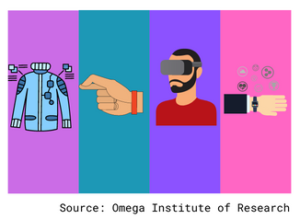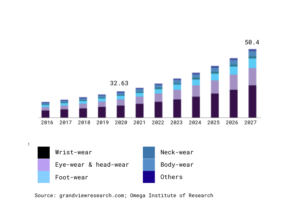- Industries
Industries
- Functions
Functions
- Insights
Insights
- Careers
Careers
- About Us
- Retail
- By Omega Team

Wearable devices have earned a steady following among consumers for the last ten years. Smartwatches like Apple Watch are the most well-known wearables, but more types of wearables have emerged and continue to emerge. These devices can be connected to computers and smartphones, performing computing functions. They also provide unique services such as health tracking and monitoring.
Figure 1: Different types of wearable devices

Wearables will become more common, including in the workplace. Companies will be able to take advantage of these technologies to increase productivity. Wearables are convenient at some working conditions, allowing employees to do some work through them without turning on their phones or computers. In addition, they can be used as part of employee benefits to detect and remind employees of their real-time well-being status. Meanwhile, wearables can get more attention through elaborate design so that employees will be happy to wear it, making it an icon of the company.
Different Types of Wearables
Smartwatches
Smartwatches are likely the most commonly known and commonly-used smart wearables in the workplace today. Connecting a smartwatch to a smartphone enables the wearer to read and send new messages from their watch, eliminating the need to hold and view one’s phone. As the most common of the different types of wearable technology examples, smartwatches can be a distraction in the workplace; even if workers’ smartphones are stowed away during a meeting, workers can read the news and communicate with each other using their smartwatches.
Smart Jewlery
As compared to a smartwatch, smart jewelry may offer a less intrusive means of monitoring one’s health in the office, without compromising the health insights that one can obtain. Companies looking to promote active lifestyles may consider subsidizing or providing employees with smart rings or other jewelry in place of smartwatches.
Smart Clothing
Wearable technology is attempting to merge with the fashion industry. Some feature meshed wiring woven into the fabric, while others contain hardware that connects via Bluetooth to a smartphone. The Commuter x Jacquard is part of a collaboration between Levi’s and Google. This non-stretch denim jacket connects to your smartphone via Bluetooth, and can screen phone calls, control music volume, and even notify you when your rideshare is nearby. In addition, some smart glasses are created to provide convenient shooting functions, such as Snapchat’s smart glasses. These glasses keep developing new generations that offer higher quality photos and video while making the camera smaller and more invisible. Smart Clothing touches a large amount of the human body, so it provides more detailed and insightful medical and lifestyle information and advice than any other wearable product.
Nadi X yoga pants can sense your yoga pose needs refining, Sensoria Fitness Socks use advanced textile sensors built into each sock, plus a connected anklet device, to deliver precise data on how your foot lands while walking or running, and Naviano smart swimsuits that provide alerts when the user should apply sunscreen, among many other kinds of smart clothing. Siren’s smart socks, officially referred to as Siren’s Diabetic Socks and Foot Monitoring System, use small sensors placed throughout the socks’ fabric to measure the foot’s temperature at six different points. This data can detect ulcerations which often result in amputations.
Head-Mounted Displays (HMDs)
Provide a display in the user’s field of view, such that the user can use the device without needing to look down at a phone or smartwatch display. HMDs can provide one of several kinds of experiences for users: HMDs can function as monitors, provide information superimposed over reality via augmented reality (AR), or completely immerse the user in virtual reality (VR) setting.
Wearable Devices in Healthcare
Some smartwatches and wristband devices are equipped with sensors to keep track of users’ physical activity and heart rate. Many fitness trackers provide health and wellness recommendations by syncing to various smartphone apps. By 2024, the number of users of smartwatches is expected to surpass 50 million. The development of wearable devices is a boon for patients with cardiovascular disease. They can replace traditional devices, bring real-time monitoring and provide more assurance for patients’ health and safety. Wearable ECG monitors are on the cutting edge of consumer electronics. They are able to measure electrocardiograms, or ECGs—helping users track their heart rhythm and rate, as well as to measure other vitals, including blood pressure. A wearable blood pressure monitor measures blood pressure and daily activity, including steps taken and calories burned.
Wearables are not limited to clothes, the implantables that make contact with the user’s body from the inside rather than on the skin can also be choices for some patients. For instance, the now-bankrupt company Proteus produced sensor-containing pills that could monitor blood pressure and other health metrics; after the patient swallowed the pills, they could wear an external device to easily monitor the data generated from within the body. In the near future, smart tattoos may also become available for patients who want an easy way of ensuring that they always remember to bring their monitoring devices with them.
In addition to monitoring some basic biological indicators, wearable biosensors are under development to enhance this function. They are garnering substantial interest due to their potential to provide continuous, real-time physiological information via dynamic, noninvasive measurements of biochemical markers in biofluids, such as sweat, tears, saliva and interstitial fluid. Recent developments have focused on electrochemical and optical biosensors, together with advances in the noninvasive monitoring of biomarkers including metabolites, bacteria and hormones. A combination of multiplexed biosensing, microfluidic sampling and transport systems have biofluids. Has been integrated, miniaturized and combined with flexible materials for improved wearability and ease of operation. Wearable biosensors are analytical devices still in their infancy stage in regard to large-scale development and adoption, yet they hold the potential to revolutionize telemedicine and remote healthcare. These devices are portable sensors that come in the form of gloves, clothing, bandages, and implants. They create two-way feedback between the user and their doctor and enable continuous and noninvasive disease diagnosis and health monitoring from physical motion.
Benefits of Wearable Health Technology
Real-Time Data Collection
The first benefit wearables bring is that they collect realtime data. They collect additional biometric data like blood glucose levels and blood pressure through non-invasive sensors in real-time. These metrics are critical information for providers dealing with patients with congestive heart failure, diabetes, and other chronic conditions. Moreover, they collect contextual and continuous data instead of a snapshot in a time that clinical monitoring provides. This will improve the analysis of the patient’s health and treatment outcomes.
Wearables are also able to produce predictions and avoid risk based on the data they collect. For example, in patients with conditions such as congestive heart failure, life-threatening behaviors can include changes in sleep and activity levels. Data collected by wearables can be used to predict an increased risk of a potentially fatal health event and alert healthcare providers that an intervention might be needed.
These devices also empower patients in maintaining their health. Most patients want to have a role in improving their health. These devices are allowing patients to interact with their health and lifestyle behaviors in an unprecedented way. Patients who are more aware of the immediate repercussions of their lifestyle choices are likely more motivated to change and understand long-term effects as well.
Consumer-focused, affordable devices are sure to be a critical component of the future of healthcare. As the industry shifts focus to positive patient outcomes, the benefits of incorporating wearables in individual patient care and population health management is increasingly undeniable.
The Disadvantages of Wearable Technology
Despite all the benefits that wearables bring, there are few disadvantages worth attention to. Poor data quality, poor design or unfashionable design of the device are some of the concerns. While there are numerous advantages to quantifying your health, there are also many disadvantages. Having access to a large amount of data about your health can make users become obsessive or even hypochondriac. Much like Googling your symptoms may be misleading, having access to data, that could have errors, could lead to irrational fears and health scares. Moreover, an issue with waterproofing designs often comes up with these devices. Sweat and bad weather such as heat and precipitation are two sources of damage to the technology. In addition, a device’s small size can result in small and difficult screens to view information as well as “constrained power reserves”. The smaller the device, the smaller the battery and therefore the shorter the battery life.
Market Forecast
The global wearable technology market size was valued at USD 32.63 billion in 2019 and is projected to expand at a compound annual growth rate (CAGR) of 15.9% from 2020 to 2027. In 2019, over half (50.4%) of the American population will wear a smartwatch routinely. 38% of wearable users are between the ages of 25 and 34. The growing popularity of the Internet of Things (IoT) and connected devices and the rising technically sound population are expected to drive the demand. Rising concerns of obesity and other chronic diseases have led to the adoption of wearable products such as body monitors and activity trackers.
Figure 2: US Wearable Technology Market Size, by Product, 2016-2027 (USD Billion)

Conclusion
Wearable technology is a great help for monitoring and advising on human health in general. It provides continuous, real-time data to help doctors diagnose. In addition, with the integration of biosensors, its health management capabilities will be greatly enhanced. Meanwhile, the problem of battery consumption and the quality of data need to be studied and solved. Wearables can be designed more delicately to cater to people’s fashion needs. It can be predicted that this technology has a huge market potential for all age groups in the future.
Subscribe
Select topics and stay current with our latest insights
- Functions